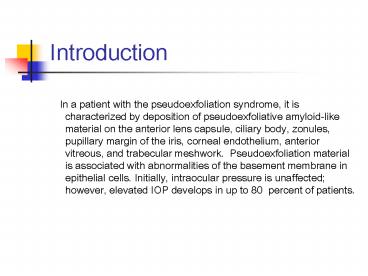In a patient with the pseudoexfoliation syndrome, it is characterized by deposition of pseudoexfoli - PowerPoint PPT Presentation
1 / 8
Title:
In a patient with the pseudoexfoliation syndrome, it is characterized by deposition of pseudoexfoli
Description:
... is characterized by deposition of pseudoexfoliative amyloid-like material on the ... Pseudoexfoliation material is associated with abnormalities of the basement ... – PowerPoint PPT presentation
Number of Views:492
Avg rating:3.0/5.0
Title: In a patient with the pseudoexfoliation syndrome, it is characterized by deposition of pseudoexfoli
1
Introduction
- In a patient with the pseudoexfoliation
syndrome, it is characterized by deposition of
pseudoexfoliative amyloid-like material on the
anterior lens capsule, ciliary body, zonules,
pupillary margin of the iris, corneal
endothelium, anterior vitreous, and trabecular
meshwork. Pseudoexfoliation material is
associated with abnormalities of the basement
membrane in epithelial cells. Initially,
intraocular pressure is unaffected however,
elevated IOP develops in up to 80 percent of
patients.
2
Case
- A 60-year-old man, had been treated for
pseudoexfoliation syndrome and cataract, visited
the hospital for abruptly developed visual
disturbance and ocular pain in both eyes. Visual
acuity was finger count 30cm in the right eye and
finger count 10cm in the left eye. Intraocular
pressure was 47mmHg in the right eye and 52mmHg
in the left eye. Slit lamp examination showed
cornea with microcyst and shallow anterior
chamber( V.H. grade I) Laser iridotomy was
performed in the right eye and cataract operation
with surgical iridectomy was done in the left eye
due to significant posterior polar lens
opacity. 6 months after treatment, Visual acuity
was 0.8(1.0) in the right eye and 1.0 in the left
eye. Intraocular pressure was 14 mmHg in the
right eye and 12 mmHg in the left eye.
3
Case
1-A
1-A
1-B
Fig.1. A pseudoexfoliation material is on the
anterior lens capsule in the right eye (A) and
the left eye (B) on the initial examination. This
figure shows an edematous cornea with Descemets
membrane folding on both eyes.
4
Case
2-A
2-B
Fig.2. Laser iridotomy was perfomed at 11 oclock
in the right eye (A) and cataract operation with
surgical iridectomy was done in the left eye.(B)
5
Conclusion
- In 1917, Lindberg1) first described
pseudoexfoliation syndrome. This entity is
characterized by flakes of granular material at
the pupillary margin of the iris and throughout
the inner surface of the anterior chamber.
Dvorak-Theobald2) recommended the term
pseudoexfoliation of the lens capsule to
distinguish the condition from capsular
delamination or true exfoliation. It is also
associated with secondary open-angle glaucoma,
known as pseudoexfoliation glaucoma, which is the
most common identifiable form of secondary
open-angle glaucoma worldwide. But glaucoma is
not always present in eyes with this disorder but
when it does occur in association with the
pseudoexfoliation syndrome, the condition has
been called glaucoma capsulare, capsular
glaucoma, or pseudoexfoliation glaucoma.
6
Conclusion
- In one study of patients with the
pseudoexfoliation syndorme but without glaucoma
on the initial examination, one third developed
glaucoma during 1.5-year follow up3). Some
patient with bilateral pseudoexfoliation syndrome
have glaucoma in both eyes, but others have a
pressure rise in only one of the eyes with
pseudoexfoliation. Most eyes with
pseudoexfoliation syndrome have an open angle
mechanism, although acute angle-closure glaucoma
also occurs in a small number of cases4). In one
series of 139 pseudoexfoliation syndrome patients
presenting with acute glaucoma, 86 had open
angles, 18 had angle closure, 21 had neovascular
glaucoma, and 14 had absolute glaucoma. Mechanism
of rise in IOP in pseudoexfoliation syndrome
associated open angles may include local
production of pseudoexfoliation mateiral,
endothelial cell damage of the trabecular
meshwork and passive deposition of
pseudoexfoliation material and pigment
originating from elsewhere in the anterior
segment.
7
Conclusion
- A less common mechanism of glaucoma in
patient with pseudoexfoliation syndrome is acute
or chronic angle-closure glaucoma5). A number of
mechanisms may create a tendency toward pupillary
block and angle closure including zonular
weakness, causing anterior movement of the lens
lens thickening from cataract formation
increased adhesiveness of the iris to the lens
due to pseudoexfoliation material, sphincter
muscle degeneration, and uveitis and iris
rigidity from hypoxia. The treatment of
pseudoexfoliation glaucoma is the same as that of
primary open-angle glaucoma however, topical
medications tend to be less effective. When
medical therapy is no longer adequate, Argon
laser trabeculoplasty is frequently used with
excellent initial success. Intraocular pressure
appears to decrease in pseudoexfoliation eyes
after phacoemulsification cataract extraction6
8
Reference
- 1. Lindberg JG. Clinical investigations on
depigmentation of the pupillary border and
translucency of the iris in cases of senile
cataract and in normal eyes in elderly persons.
Academic Dissertation, Helsinki, 1917. English
translation by Tarkkanen A, Forsius H. Acta
Ophthalmol 198966(Suppl 190), Helsinki,
University Press. - 2. Dvorak-Theobald G. Pseudo-pseudoexfoliation of
the lens capsule relation to true
pseudoexfoliation of the lens capsule as reported
in the literature and role in the production of
glaucoma capsulocuticulare. Am J Ophthalmol
1954371 - 3. Slagsvold JE. The follow-up in patients with
pseudoexfoliation of the lens capsule with and
without glaucoma. 2. The development of glaucoma
in persons with pseudoexfoliation. Acta
Ophthalmol 198664241 - 4. Gillies WE, Brooks AMV. The presentation of
acute glaucoma in pseudoexfoliation of the lens
capsule. Aust N Z J Ophthalmol 198816101 - 5. Wishart PK, Spaeth GL, Poryzees EM. Anterior
chamber angle in the pseudoexfoliation syndrome.
Br J Ophthalmol 198569103 - 6. Merkur A, Damji KF, Mintsioulis G, et al.
Intraocular pressure decrease after
phacoemulsification in patients with
pseudoexfoliation syndrome. J Cataract Refract
Surg 200127528

